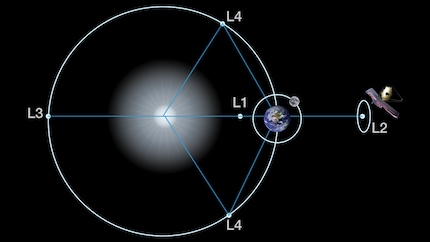
Background information
I tried to develop better images than NASA – and failed
by Samuel Buchmann

The James Webb Space Telescope is a completely insane project. It’s job is to image galaxies so far away that they show the universe at a very early stage. The telescope was launched into space on Christmas Day.
This somewhat special date wasn’t planned, but the result of several postponements. But all went well, and the Ariane 5 rocket was sent up to space on December 25, 2021, at 1:20 p.m. Central European Time. On board is the 6500-kilogramme heavy James Webb Space Telescope, or JWST. It’s expected to mark a new milestone in space exploration.
The most significant space telescope to date is the Hubble Telescope. But the JWST is much larger, more expensive, more powerful and more ambitious. However, it will not replace the Hubble telescope but complement it.
Unlike the Hubble telescope, the JWST is not intended to perform its service in Earth orbit. Its destination is 1.5 million kilometres away from our planet. That’s much farther away than the moon, which circles at a distance of about 384,000 kilometres. This great distance has many advantages. Firstly, planet Earth is not blocking a large part of its view – the JWST can inspect space in all directions. Secondly, the telescope escapes earth’s heat radiation. The telescope generates shade itself with a kind of sun protection. In the shade temperature cools down to –235 degrees Celsius. You’ll see why this is important in a moment.
The telescope will be flown to a special place called Lagrange point 2 (L2), where the gravitational forces of the Sun and Earth balance each other out. This allows it to maintain its position with relatively little effort. Five of these Lagrange points are known; L2 is the only one farther from the Sun than the Earth.

However, this great distance also has its disadvantages. If something breaks, it’s not as if you can just send a few astronauts up to fix the telescope. The JWST can’t be maintained. And the probability of something breaking is high. Even the Hubble telescope delivered useless images at the beginning. And then bobbed around broken in orbit broken for three years before it was repaired.
Another disadvantage of its location: as the telescope needs fuel to maintain itself at point L2, the lifetime is limited to a maximum of ten years.
The JWST has a much larger mirror than the Hubble telescope and is about six times as sensitive to light. Most importantly, it can capture and image a much larger portion of the infrared spectrum. Because of this optimisation to infrared, the mirror has a golden colour. In fact, the surface is made of gold, because the precious metal is particularly durable.
Infrared radiation is also heat radiation. The colder the environment, the greater the chance that weakly radiating objects can be detected and imaged. That’s why the telescope is flown to an extremely cold place.
But why infrared at all? First of all, infrared waves penetrate cosmic dust better than visible light. This means objects behind cosmic dust clouds are easier to detect and image.
What’s more, the JWST should be able to make extremely distant celestial bodies visible. Much more so than the Hubble telescope. This includes galaxies in a very early state of space history. The light or the infrared of the most distant objects takes billions of years to reach us. This means that what we see today is what was going on billions of years ago. Hubble was already able to make galaxies visible that are so far away, we can see them as if they had emerged a mere few hundred million years after the Big Bang.

Infrared is necessary because of the so-called redshift. An object moving away from us has longer waves than when it remains still or is moving towards us. Infrared waves are longer than visible light. Oddly enough, all distant galaxies have this redshift, which means they’re all moving away from us. From this, science concludes that the universe is expanding.
It will be another six months before JWST is fully operational. Always assuming that everything works out the way it should. The whole undertaking is extremely ambitious and risky. In a complicated mechanical process, the telescope needs to unfold during its journey to L2. Apparently, there are about 300 things that could go wrong in the process – not counting Murphy’s Law ...
Watch the launch here.
My interest in IT and writing landed me in tech journalism early on (2000). I want to know how we can use technology without being used. Outside of the office, I’m a keen musician who makes up for lacking talent with excessive enthusiasm.
Interesting facts about products, behind-the-scenes looks at manufacturers and deep-dives on interesting people.
Show all